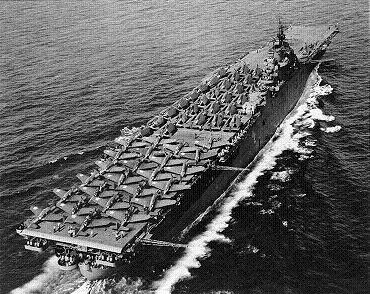![]() The Pacific War Online Encyclopedia
The Pacific War Online Encyclopedia
|
| Previous: Flamethrowers | Table of Contents | Next: Fleet Faction |

Fleet carriers were the largest class of carriers to see combat, having excellent speed (30+ knots), some measure of protection, and the ability to operate air groups of 60 or more aircraft.
The ability of a fleet carrier to operate a large air group depended on its deck area and speed. Both the American and Japanese navies based their carrier tactics on the deck load strike, whose size was limited by the number of aircraft that could be spotted on deck for takeoff. The faster the carrier, the shorter the takeoff run required, and the further forward aircraft could be spotted. In general, aircraft could not be simultaneously landed and launched because only one end of the flight deck could be cleared at a time. Launching a strike took about half an hour, while landing the returning strike took a full hour.
Some measure of protection,
particularly against bombs and torpedoes,
was also desirable. With speed and
deck area as principal design parameters, protection was usually
limited to a
lightly armored hangar deck, torpedo blisters, and a light armored
belt.
Armored flight decks were eschewed by the Japanese and Americans
because so
much weight so high in the ship limited the size of the air
group. The British
insisted on armored flight decks, accepting
the consequent limitations on air group size. As a result, their
fleet carriers were not much greater in offensive fighting power than
an American
light carrier, but proved
far more durable under kamikaze attack.
At the start of the Pacific War, the United States had seven fleet carriers and Japan had six. However, the Ranger was considered such a poor design that the U.S. Navy never committed her to the Pacific. Both sides built more carriers during the war, but the Japanese production did not come close to the American. The Japanese completed six fleet carriers during the war, of which the best was probably the Taiho, a very fine ship that accomplished so little only because of bad luck and a lack of good pilots. The Americans completed seventeen fleet carriers of the Essex class, excellent ships of which none was lost in combat (although there were some very close calls.) The Essexes could operate very large air groups (100 or more aircraft, in a pinch), were reasonably well protected, and carried a lethal antiaircraft battery of twelve 5”/38s and numerous lighter antiaircraft weapons. The British were able to complete a total of thirteen of their less powerful fleet carriers during the time span of the Pacific War, of which the best were probably the Implacables, which had been designed free of treaty restrictions.
Towards the end of the war, the United States launched a number of Midway-class carriers. These were designated as large carriers (CVB). They were heavily protected, with armored flight decks and extensive torpedo defenses, and were capable of operating very large air groups (up to 137 aircraft). None was commissioned in time to participate in combat operations.
American fleet carriers typically
carried four squadrons of 18 planes each. At the start of the
war, these
were a scout squadron, a
bomber squadron, a torpedo squadron, and a
fighter
squadron. The scout squadron flew the same model of dive
bombers as the
bomber squadron and usually functioned as a second bomber squadron when
it was
not performing its scouting role. The Battle of the Coral Sea convinced
the Americans that more fighters
were required, and the fighter squadron was increased to 24
aircraft.
After Midway,
the fighter contingent was increased to
two squadrons of 18 or 19 fighters, the approximate limit of what the
fleet
carriers of 1942 could operate. The authorized air group for most U.S.
fleet carriers thus became 36 fighters, 36 dive bombers, and 16 torpedo
bombers in July 1942.
As the war progressed, it was found
that there was little a
dive bomber could do that fighters or torpedo bombers could not do
as
well. The two dive bomber squadrons were reduced to 14 planes
each in
late 1943 and then to a single squadron of 15 planes by late
1944. The
number of torpedo bombers remained roughly constant as the number of
fighters
was increased. With the growing kamikaze
threat, fleet
carriers began to
ship as many fighters as could be squeezed on board -- up to 70 on an
Essex,
with the dive bomber and torpedo bomber contingents reduced to just one
squadron each of 15 planes. The Essexes
were designed to carry a fifth reserve squadron, but this promptly
became an operational fighter squadron.
Japanese fleet carrier air groups consisted of a squadron each of dive bombers, fighters, and torpedo bombers. These typically had 15 to 27 planes, depending on the operating capacity of the carrier. (Unlike American carrier air groups, each Japanese carrier air group was permanently assigned to a particular carrier.) Japanese air groups increased slightly in size and included somewhat more fighters as the war progressed, but the Japanese failure to adopt deck stowage of aircraft prevented their carrier air groups from reaching the size of their American counterparts. The Japanese were also hindered by the design of the folding wings on their aircraft, especially on the dive bombers, which could fold up little more than the wing tips.
A typical British air group in 1942 was composed of just 12 to 30 fighters and 12 to 24 torpedo bombers. Dive bombers were not carried until 1943.
References
The Pacific War Online Encyclopedia © 2007, 2009-2010 by Kent G. Budge. Index